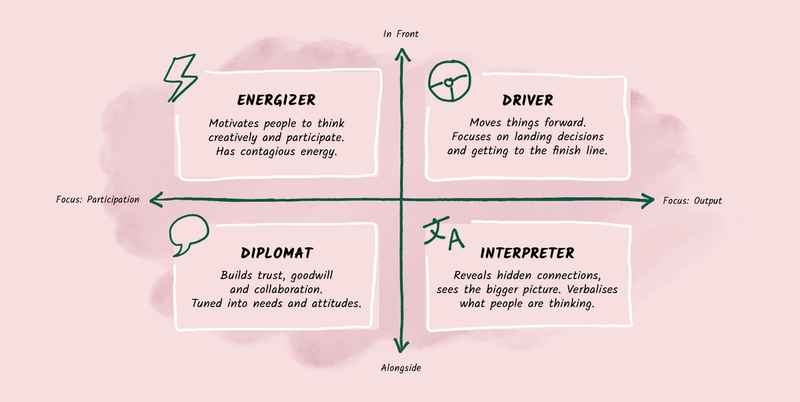Taking on the multifaceted role of facilitator can be intimidating. Get started by playing to your strengths.
4 min read
·
By Sonja Sarah Porter
·
December 2, 2021
Quick – Conjure up an image of a “facilitator.” What pops into your head first? As a UX designer, my image is heavily influenced by the era of the “Google Design Sprint.” I see a thoroughly planned workshop, with post-its covering every surface available. And the facilitator herself? Whiteboard marker in hand, she is a commanding presence in the front of the room and a major participant in discussions.

But facilitation is so much more than just this. Though a post-it wielding workshop leader is one very visible form of facilitation, facilitation as a tool that can be used in a wide variety of situations and take many forms. Unfortunately, many people shy away from facilitation because they do not feel comfortable with this traditional style – even though their teams desperately need the help.
The goals of facilitation
If you have a great team with high psychological safety and impeccable communication skills, you may be able to get by without a facilitator on your team. For the majority of us however, facilitation skills are a necessity as there are a couple of things that tend to go awry when groups of people work together. Have you ever scheduled a meeting to land a direction, discussed the issue for an hour, but left with no clear answer? Or been in a water cooler discussion with a colleague where you thought you disagreed, but found out that you were actually talking about the same thing? What about when a workshop is taken over by a strong personality, or even worse – people don’t share their opinions because there is a HiPPO in the room.
It is in these situations a facilitator can really shine. They can help to guide a group’s output, help participants understand each other’s viewpoints, create alignment and shared ownership, and moderate discussions so that everyone can participate. But there are many ways to do this, not all of which look like the typical sprint facilitator.
Like leadership, facilitation has many different styles.
Because facilitation has such a wide variety of goals, it can take a variety of forms. A facilitator can be the focal point at the front of the room, or working in the trenches. They can focus on creating engagement and participation, or ensuring useful output. Generally, facilitation falls into four “styles”:

- The Energizer: Motivates people to think creatively and participate. Has a contagious energy.
- The Driver: Keeps everyone on schedule, and maintains forward progress. Focuses on landing decisions or getting to the finish line.
- The Diplomat: Builds trust, good will, and collaboration within the group. Tuned into individual needs and attitudes in the group.
- The Interpreter: Reveals hidden connections and sees the big picture. Picks up on the essence of ideas and translates participants’ loose thoughts into clear terms.
Know your style: Play to your strengths and know your weaknesses.
An experienced facilitator switches between these styles to meet the needs of the group and situation. They put on their Energizer hat when motivation is low, but just as easily take a step back into the Interpreter when the conversation demands it. For most facilitators just getting started however, one or two of these roles comes more naturally than the others. Don’t try to be an Energizer just because that is what a typical Design Sprint facilitator looks like. Like leadership, facilitation works best if you play off of your strengths, personality and style. Weak on getting participation? Ally yourself with a participant who is good at cracking jokes and putting everyone at ease. Weak on ensuring outcomes? Display a digital timer on the board, or give a participant responsibility to watch the clock. By knowing your facilitation style, you can better play to your strengths and find ways to work around your weaknesses to step up in a big way for your team.
Happy facilitating!